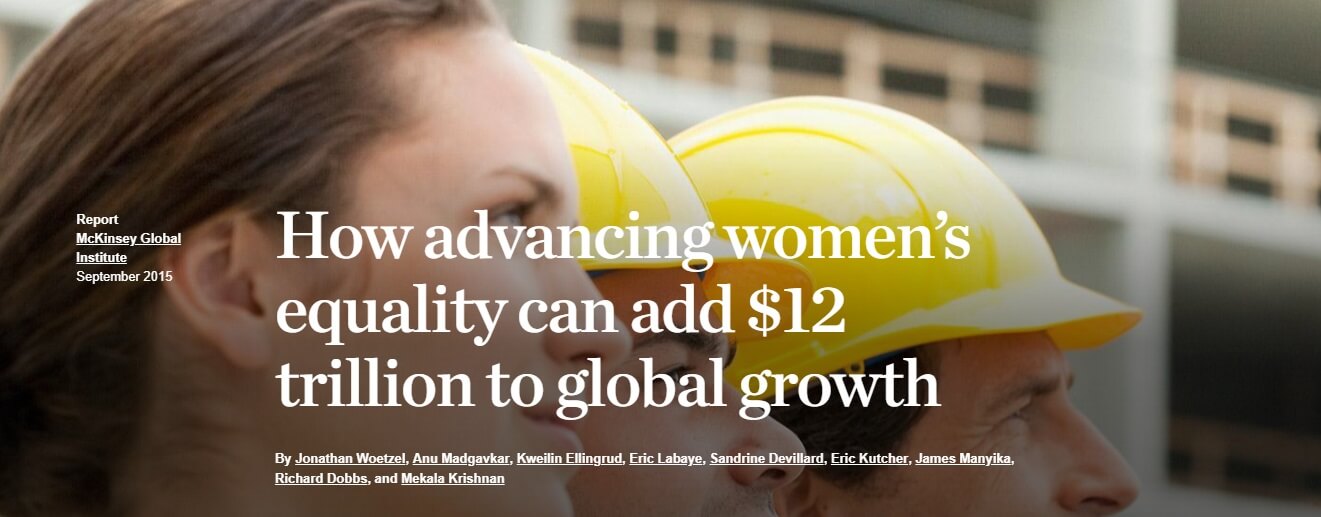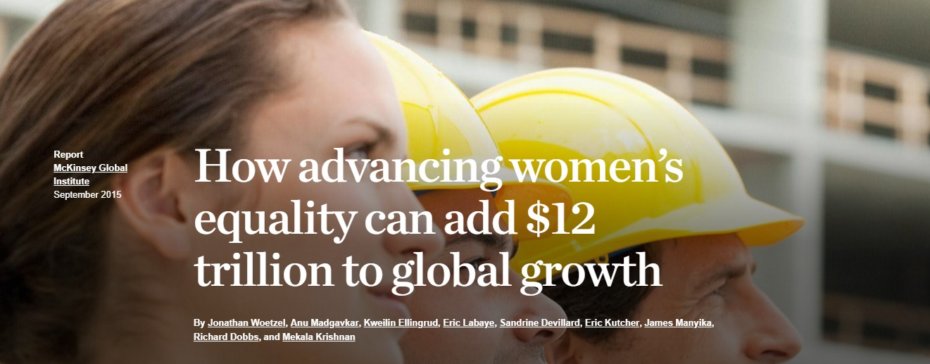
McKinsey
September 2015
By Jonathan Woetzel, Anu Madgavkar, Kweilin Ellingrud, Eric Labaye, Sandrine Devillard, Eric Kutcher, James Manyika, Richard Dobbs, and Mekala Krishnan
A new McKinsey Global Institute report finds that $12 trillion could be added to global GDP by 2025 by advancing women’s equality. The public, private, and social sectors will need to act to close gender gaps in work and society.
Gender inequality is not only a pressing moral and social issue but also a critical economic challenge. If women—who account for half the world’s working-age population—do not achieve their full economic potential, the global economy will suffer. While all types of inequality have economic consequences, in our new McKinsey Global Institute (MGI) report, The power of parity: How advancing women’s equality can add $12 trillion to global growth, we focus on the economic implications of lack of parity between men and women.
A “best in region” scenario in which all countries match the rate of improvement of the fastest-improving country in their region could add as much as $12 trillion, or 11 percent, in annual 2025 GDP. In a “full potential” scenario in which women play an identical role in labor markets to that of men, as much as $28 trillion, or 26 percent, could be added to global annual GDP by 2025. MGI’s full-potential estimate is about double the average estimate of other recent studies, reflecting the fact that MGI has taken a more comprehensive view of gender inequality in work.
Even after decades of progress toward making women equal partners with men in the economy and society, the gap between them remains large. We acknowledge that gender parity in economic outcomes (such as participation in the workforce or presence in leadership positions) is not necessarily a normative ideal, as it involves human beings making personal choices about the lives they lead; we also recognize that men can be disadvantaged relative to women in some instances. However, we believe that the world, including the private sector, would benefit by focusing on the large economic opportunity of improving parity between men and women.
A look at some of the highlights from our report:
- MGI has mapped 15 gender-equality indicators for 95 countries and finds that 40 of them have high or extremely high levels of gender inequality on at least half of the indicators. The indicators fall into four categories: equality in work, essential services and enablers of economic opportunity, legal protection and political voice, and physical security and autonomy.
- We consider a “full potential” scenario in which women participate in the economy identically to men and find that it would add up to $28 trillion, or 26 percent, to annual global GDP by 2025 compared with a business-as-usual scenario. This impact is roughly equivalent to the size of the combined Chinese and US economies today. We also analyzed an alternative “best in region” scenario in which all countries match the progress toward gender parity of the fastest-improving country in their region. This would add as much as $12 trillion in annual 2025 GDP, equivalent in size to the current GDP of Germany, Japan, and the United Kingdom combined, or twice the likely growth in global GDP contributed by female workers between 2014 and 2025 in a business-as-usual scenario.


Comments